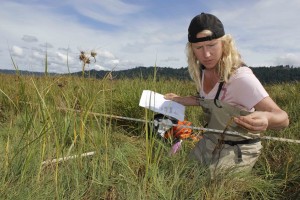
Source: Northwest Indian Fisheries Commiussion
Kneeling in a thicket of vegetation in the Skokomish estuary, Shannon Kirby combs her hands through the tall green grasses in front of her, calling out codes that identify them by size, type and abundance.
The habitat biologist for the Skokomish Tribe is studying the native freshwater and saltwater vegetation that is taking over the Skokomish estuary, which was diked and dredged for 100 years until recently.
“The response in vegetation is very promising, as is the diversity that’s out here,” Kirby said. “Estuarine plants are a huge source of food for animals, and double as a water filtration system, neutralizing pollutants and providing nutrients for plant growth. We’re right on target for where an estuary should be.”
The tribe is finding pickleweed, salt grass, sedges, rushes, sea arrow grass and Puget Sound gumweed.
Since 2010, every August, when vegetation is in full bloom, tribal staff visit 75 sites throughout the 1,000-acre estuary, looking at plant types, sizes, growth and soil composition.
These observations coincide with the tribe’s insect studies, which include conducting lavages on juvenile salmon to determine the insects they are eating.
“The quality of salmon habitat is determined by the plants that are out here and the insect food source,” Kirby said.
The tribe has been restoring the estuary at the mouth of the Skokomish River since 2007, through dike and culvert removal, large woody debris installation and native plant revegetation. Through three phases so far, the tribe has restored up to 1,000 acres of habitat for salmon and wildlife.
